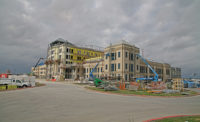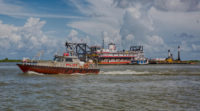Peru Project Spans One River, Three Decades


































The effort to build the longest bridge in Peru began in 1978, and, if all goes as planned, the 722-meter-long span over the Madre de Dios River in the Peruvian Amazon will be completed in December.
Constructing the Guillermo Billinghurst Bridge—a task spanning more than three decades—will cap the effort to build a paved road in South America from the Atlantic Ocean to the Pacific Ocean: the Interoceanic Highway. The $2.37-billion project to build the road across southern Peru was expanded last year to include the long-awaited span.
When completed, the $25.71-million bridge will link the city of Puerto Maldonado and the village of El Triunfo on the far side of the Madre de Dios River. The span will include a hanging structure 528 m long, making it one of the longest suspension bridges on the continent.
When Peru started work on the Billinghurst Bridge, the owner ordered the structure to be fabricated in Austria and had it delivered to South America. But economic and social turmoil in the 1980s suspended the project until 2005, when it was revived as a component of the Interoceanic Highway.
Conirsa, the consortium led by Brazilian construction firm Odebrecht, added the job in July 2009 to its contract to construct two of the three sections of the Interoceanic Highway across southern Peru.
“It’s not a job that is technically diffficult,” says Sergio Panicali, Conirsa’s director of operations. “But it’s very important that we get it completed in conjunction with the end of the highway project.”
The country’s agency overseeing infrastructure development, Ositran, had previously tried to put the bridge job out to bid but drew no interest. Conirsa’s began work in March and has completed almost a quarter of the span. The contractor expects to begin hanging the cables for the span by the end of June.
After examining components that had been stored for decades, the consortium determined that the steel body of the bridge was salvageable but not the cables. Not surprisingly, the contractor affirmed the job’s cost would exceed the government’s estimate.
“There was a great deal of rust, but not corrosion to the metal,” said Gonzalo Calderon, Conirsa’s head of engineering on the project.
Conirsa engineers found they could use about 98% of the steel on the bridge. The portions that were unusable had been damaged by a crane near a staging area at the Puerto Maldonado Airport.
While most steel pieces were in good condition, the cable was ruined by exposure for several decades to the jungle climate. The contractor ordered newly fabricated cable to support the 2,500-ton weight of the span, Calderon said.
For the job, each metal piece is being restored and then repainted, first with a protective sealant and then with the bright-orange paint that will distinguish the final bridge.
The consortium erected on either side of the river a 65-m-long “false bridge,” reaching from the bank to pylons constructed in the river. The false bridge will support the metal frame of the span being put into place in advance of the towers, both of which will be 40 m high. Once the towers are built, the cables will be put in place, and the roadway—a continuous slab of concrete 20 centimeters thick with a 5-cm-thick layer of asphalt—will be supported by them from above.
The bridge is named in honor of Peru’s president from 1912 to 1914. Billinghurst, a millionaire businessman, was a populist former mayor of Lima who reached the country's highest office after organizing a strike that ousted the administration.
Currently, access to Peru’s southern Amazon region is hindereded by the Madre de Dios River. Travelers must cross...
























